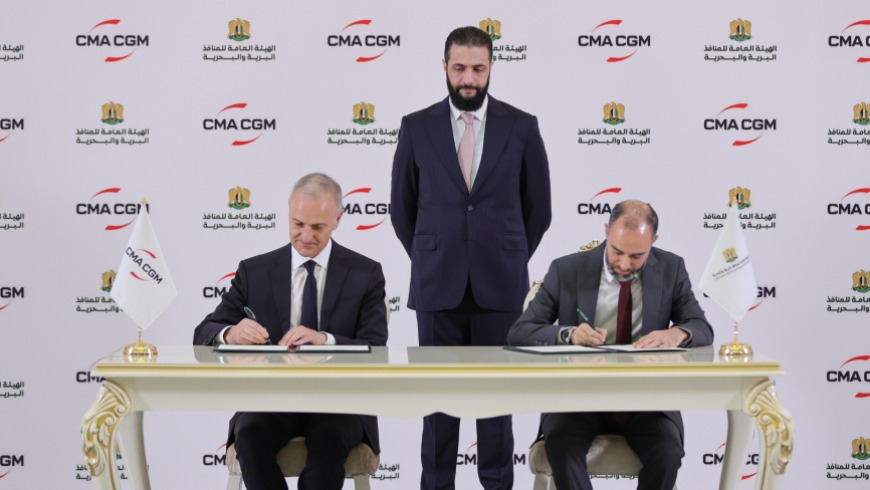After over a decade of war, economic collapse, and international isolation, Syria is cautiously charting a path back into the global economic order. Under the leadership of President Ahmad al-Sharaa, the transitional government has launched a series of initiatives—from foreign investment deals and financial diplomacy to digital reform and regional energy partnerships—signalling a coordinated effort to rebuild the nation’s shattered economy and regain international legitimacy.
At the heart of this effort is a landmark agreement with the French shipping giant CMA CGM to invest in and operate the container terminal at the Port of Lattakia. While this deal has been hailed as a breakthrough in Syria’s post-conflict reconstruction, it has also sparked domestic debate and misinterpretation. In reality, it is both a substantive economic investment and a carefully crafted political message, aimed at both internal and external audiences.
I. The Lattakia Port Deal: Substance or Spectacle?
In early May 2025, Syria’s General Authority for Land and Maritime Ports signed a €230 million agreement with CMA CGM, granting the French firm a 30-year concession to modernise and operate the Lattakia container terminal. The agreement includes construction of a new deep-water berth and provisions to gradually raise Syria’s revenue share to 70%—a notable improvement over past arrangements.
Some commentators have framed the deal as a sign of France’s renewed confidence in Damascus. But such interpretations ignore key facts: CMA CGM has managed the Lattakia terminal since 2009 via a joint venture with Syria Holding, maintaining operations even during the height of Syria’s civil war. Far from a dramatic geopolitical shift, the new agreement reflects continuity and the scaling-up of an existing partnership.
The ceremonial setting of the signing—held at the People’s Palace with President Sharaa in attendance—has also drawn criticism. Yet this display was not merely pageantry. Coming just days after sectarian unrest in Jaramana and Sahnaya, the ceremony was a calculated attempt to project stability and reassert state authority.
Symbolism aside, the deal is economically significant. It is Syria’s largest foreign investment since the fall of the Assad regime, and arguably the most credible international venture since the 2019 Tartus port lease to Russia’s Stroytransgaz, which has yet to deliver on promised development.
The investment also carries geopolitical weight. The Saadé family, owners of CMA CGM, maintain close ties to French President Emmanuel Macron, and the company is regarded as a key player in France’s commercial and intelligence architecture. Macron’s first direct call with President Sharaa came within hours of the deal’s initial announcement—an indicator of high-level endorsement.
Lattakia’s strategic position on the Eastern Mediterranean places France amid a delicate regional balance involving Turkey, Greece, and Cyprus. That the deal moved forward suggests at least tacit Turkish consent, bolstering Syria’s claim of increasing foreign policy autonomy even amid alignment with Ankara.
II. Beyond Lattakia: The Broader Realignment
The Lattakia agreement is part of a wider effort to rebuild Syria’s economic architecture, combining institutional reform with pragmatic diplomacy.
Renewed Engagement with International Financial Institutions
In a notable development, Syria has re-engaged with the International Monetary Fund (IMF) after two decades of near dormancy. Damascus attended the IMF Spring Meetings for the first time since 2004, and a new mission chief, Ron van Rooden, has been appointed to oversee engagement.
This shift follows quiet Saudi diplomacy, including a $15 million payment of Syria’s arrears to the World Bank, enabling access to concessional financing.
Meanwhile, the UNDP secured a waiver from the U.S. Treasury to mobilise $50 million for restoring the Deir Ali power station—a rare sanctions exception that underscores Syria’s slow but real financial reintegration.
Domestic Reform and Digital Initiatives
Domestically, the government is attempting to modernise public finance and service delivery. The launch of “Sham Cash”, a mobile salary disbursement app, marks Syria’s first serious step into e-governance. Although plagued by connectivity issues and digital illiteracy, the initiative signals a shift towards transparency and anti-corruption.
In tandem, the UNDP has launched a subsidised loan programme in partnership with four Syrian banks, providing microloans to over 1,600 individuals. This modest but symbolically important step seeks to restore public trust in the banking system and support inclusive recovery.
Regional Energy Diplomacy
Syria’s electricity infrastructure remains severely damaged, with blackouts lasting up to 20 hours daily. The government has responded with energy cooperation deals with Qatar and Azerbaijan.
In March 2025, a Qatari-funded gas pipeline via Jordan came online, supplying 2 million cubic metres of gas per day—enough to generate 400 megawatts of power. Talks with Azerbaijan have focused on renewable energy and technical assistance, laying the groundwork for long-term energy resilience and expanded regional ties.
III. A Fragile Recovery Amid Deep Crisis
Despite these efforts, Syria’s economy remains in crisis. A recent analysis by economist Manaf Quman revealed:
-
80% of the population lives below the poverty line
-
The Syrian pound has lost 99% of its value
-
Key sectors—energy, agriculture, industry—remain devastated
-
$300 billion in estimated war-related losses
In response, the Ministry of Economy is implementing a phased recovery plan, prioritising:
-
“Recovery Bonds” to tap Syrian diaspora capital
-
Revival of agriculture via subsidised inputs and microloans
-
Public-private partnerships for infrastructure repair
-
Temporary job schemes, such as debris clearance
-
Selective international aid—minimising politically fraught conditionalities
The emphasis is on low-cost, high-visibility interventions in food security, employment, and basic services.
Conclusion: A Doctrine of Pragmatic Reintegration
Syria’s economic policy in 2025 reflects more than ad hoc initiatives—it signals the emergence of a doctrine of pragmatic reintegration. This doctrine hinges on:
-
Openness to foreign investment
-
Tactical engagement with regional powers
-
Cautious re-entry into Western financial systems
-
A domestic focus on inclusivity, services, and economic trust
Yet challenges remain formidable. The Sharaa administration must balance international reintegration with domestic legitimacy, all while navigating sanctions, institutional fragility, and a war-weary population.
Every agreement—such as that at Lattakia—is at once an economic contract, a political signal, and a strategic manoeuvre in Syria’s complex recovery.


